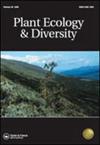Current and future distributions of Espeletiinae (Asteraceae) in the Venezuelan Andes based on statistical downscaling of climatic variables and niche modelling
IF 1.6
4区 生物学
Q2 PLANT SCIENCES
引用次数: 12
Abstract
ABSTRACT Background: Páramos are the high-elevation ecosystems of the humid tropical Andes, characterised by the presence of giant rosettes of the Espeletiinae subtribe (Asteraceae). Forecasted climate change is likely to reduce the extent of the area climatically suitable/occupied currently by Espeletiinae and their elevation distribution patterns. Aims: The aim of this study was to estimate the potential impacts of forecasted climate change on the geographic distribution (extent of area and elevation distribution patterns) of 28 species of Espeletiinae that have been recorded in the Cordillera de Mérida, Venezuela. Methods: Six bioclimatic variables, downscaled to a 90 m × 90 m cell size, were used to construct species distribution models (SDM) for the 28 species to model their current and likely future distribution (2070) by using two general circulation models and four representative concentration pathways (RCP). Results: Nine species were estimated to have potential distribution over less than 1000 km2 and five over less than 500 km2, in current climatic conditions. Fifteen and eight species had elevation spans narrower than 1000 m and 500 m, respectively. No significant differences in modelled areas or spans were detected between north, central and south sections of the Cordillera de Mérida. Mean ± SE future reduction in the extent of area climatically suitable were estimated between 51.3% ± 6.3% (RCP2.6) and 78.1% ± 5.3% (RCP8.5), coupled with upward range retreat of between 277.8 m ± 27.4 m (RCP2.6) and 762.5 m ± 59.8 m (RCP8.5). Conclusions: Our study predicts large reductions in modelled area and important upward shifts in the distribution of Venezuelan Espeletiinae by 2070 compared to their current distribution.基于气候变量的统计降尺度和生态位模型的委内瑞拉安第斯山脉星科植物的当前和未来分布
背景:Páramos是潮湿热带安第斯山脉的高海拔生态系统,其特征是存在着巨莲座星属亚族(菊科)。预测的气候变化可能会减少目前气候适宜/占据的面积及其海拔分布格局。目的:研究预测气候变化对委内瑞拉科迪勒拉德姆萨里达地区28种Espeletiinae物种地理分布(面积范围和海拔分布格局)的潜在影响。方法:利用缩小到90 m × 90 m细胞尺寸的6个生物气候变量,构建了28个物种的物种分布模型(SDM),利用2个环流模型和4个代表性浓度途径(RCP)来模拟它们当前和未来(2070年)的分布。结果:在当前气候条件下,有9种潜在分布面积小于1000 km2, 5种潜在分布面积小于500 km2。海拔跨度小于1000 m的有15种,小于500 m的有8种。在模拟区域或跨度上,在姆萨里达山脉的北部、中部和南部之间没有发现显著差异。未来气候适宜面积的平均±SE减少幅度在51.3%±6.3% (RCP2.6) ~ 78.1%±5.3% (RCP8.5)之间,向上退缩幅度在277.8 m±27.4 m (RCP2.6) ~ 762.5 m±59.8 m (RCP8.5)之间。结论:我们的研究预测,与目前的分布相比,到2070年,模拟面积将大幅减少,委内瑞拉Espeletiinae的分布将大幅上升。
本文章由计算机程序翻译,如有差异,请以英文原文为准。
求助全文
约1分钟内获得全文
求助全文
来源期刊

Plant Ecology & Diversity
PLANT SCIENCES-
CiteScore
3.30
自引率
0.00%
发文量
26
审稿时长
3 months
期刊介绍:
Plant Ecology and Diversity is an international journal for communicating results and novel ideas in plant science, in print and on-line, six times a year. All areas of plant biology relating to ecology, evolution and diversity are of interest, including those which explicitly deal with today''s highly topical themes, such as biodiversity, conservation and global change. We consider submissions that address fundamental questions which are pertinent to contemporary plant science. Articles concerning extreme environments world-wide are particularly welcome.
Plant Ecology and Diversity considers for publication original research articles, short communications, reviews, and scientific correspondence that explore thought-provoking ideas.
To aid redressing ‘publication bias’ the journal is unique in reporting, in the form of short communications, ‘negative results’ and ‘repeat experiments’ that test ecological theories experimentally, in theoretically flawless and methodologically sound papers. Research reviews and method papers, are also encouraged.
Plant Ecology & Diversity publishes high-quality and topical research that demonstrates solid scholarship. As such, the journal does not publish purely descriptive papers. Submissions are required to focus on research topics that are broad in their scope and thus provide new insights and contribute to theory. The original research should address clear hypotheses that test theory or questions and offer new insights on topics of interest to an international readership.
 求助内容:
求助内容: 应助结果提醒方式:
应助结果提醒方式:


